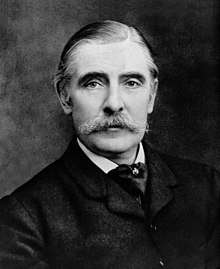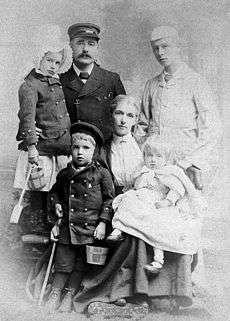Francis Champneys
| Sir Francis Henry Champneys FRCP | |
|---|---|
 | |
| Born |
25 March 1848 Nutley, SussexUK |
| Died | 30 July 1930 |
| Residence | United Kingdom |
| Education | St Bartholomew's Hospital |
| Known for |
Raising the status of midwives Founding the History of Medicine Society at Royal Society of Medicine Crown nominee of GMC 1911-1926 |
| Scientific career | |
| Fields | physician, obstetrician and historian |
| Influences | Robert Bridges |

Sir Francis Henry Champneys, 1st Baronet, FRCP (25 March 1848, London – 30 July 1930, Nutley, Sussex, England)[1][2] was an eminent obstetrician known for raising the status of midwives in the early twentieth century, by his campaigning for their training and certification and for supporting the founding of the History of Medicine Society in 1912.[3][4]
Early years
Champneys was born in the rectory of St Mary's, Whitechapel on 25 March 1848. His father was William Champneys, rector of St Mary's at the time of Champneys birth, then Canon of St Paul's and later Dean of Lichfield from 1868 to 1875.[1][5][6] Amongst his six siblings were the architect and author Basil Champneys and the rowing clergyman Weldon Champneys.[7] As a child and before the invention of perforation, Champneys would spend Sunday afternoons cutting sheets of stamps. He was awarded a scholarship to be educated at Winchester and later Brasenose College, Oxford. He then, in 1871, became a medical student at St Bartholomew's Hospital, qualifying in 1888.[8][9]
Career
Champneys was a fellow of the Royal Medical and Chirurgical Society and was elected president of its successor organisation, the Royal Society of Medicine, in 1912. He supported Sir William Osler in the founding of The History of Medicine Society at The Royal Society of Medicine, London in the same year.[4]
Legacy
The first midwives act, 1902 and the central midwives board.
Champneys particularly championed raising the status of midwives and was the main driving force of the first midwives act of 1902, which he did by being the first chairman of the Central Midwives’ Board from 1902 until his death in 1930. The act required midwives to be trained and examined in a maternity hospital. They then had to be on the register of the central midwives board.[1][9] He was the crown nominee from 1911 to 1926 of the General Medical Council. Champneys was created a baronet in 1910.[1]
Music
Champneys was an amateur musician, studying under Charles Wesley at Winchester. Whilst at Brasenose, Champneys composed a number of glees and madrigals, founding at the same time, a glees club. Later, he was to study music under John Goss (composer) and held various musical positions between 1880 and 1913.[1][9]
Death
He died on 31 July 1930 at age 83 years at his Nutley home and was succeeded by his son, Weldon Dalrymple-Champneys, who also became a physician. Weldon never had children and the baronetcy therefore ended.[6]
References
| Wikimedia Commons has media related to Francis Champneys. |
- 1 2 3 4 5 Francis Henry Champneys. hymntime.com
- ↑ Sir Francis Henry Champneys (1848–1930), Bt, DM, FRCP. BBC
- ↑ J. S. Fairbairn, ‘Champneys, Sir Francis Henry, first baronet (1848–1930)’, rev. June Hannam, Oxford Dictionary of National Biography, Oxford University Press, 2004 accessed 26 June 2012
- 1 2 Hunting, Penelope (2002). The History of The Royal Society of Medicine. Royal Society of Medicine Press. pp. 331–333. ISBN 1853154970.
- ↑ William Weldon Champneys. NPG. Retrieved on 5 June 2014.
- 1 2 Dalrymple-Champneys, Weldon (1963). "Sir Francis Champneys" (PDF). Proceedings of the Royal Society of Medicine. Royal Society of Medicine. 56: 26–27. PMC 1896747. PMID 14044494.
- ↑ ‘CHAMPNEYS, Sir Francis (Henry)’, Who Was Who, A & C Black, 1920–2008; online edn, Oxford University Press, Dec 2007 accessed 26 June 2012
- ↑ Stanford. Stanford.edu. Retrieved on 5 June 2014.
- 1 2 3 Shaw, W. Fletcher (1953-01-17). "The Central Midwives Board and Sir Francis Champneys". Br Med J. 1 (4802): 158–158. doi:10.1136/bmj.1.4802.158. ISSN 0007-1447.
| Baronetage of the United Kingdom | ||
|---|---|---|
| New creation | Baronet (of Littlemeads in the County of Sussex) 1910–1930 |
Succeeded by Weldon Dalrymple-Champneys |